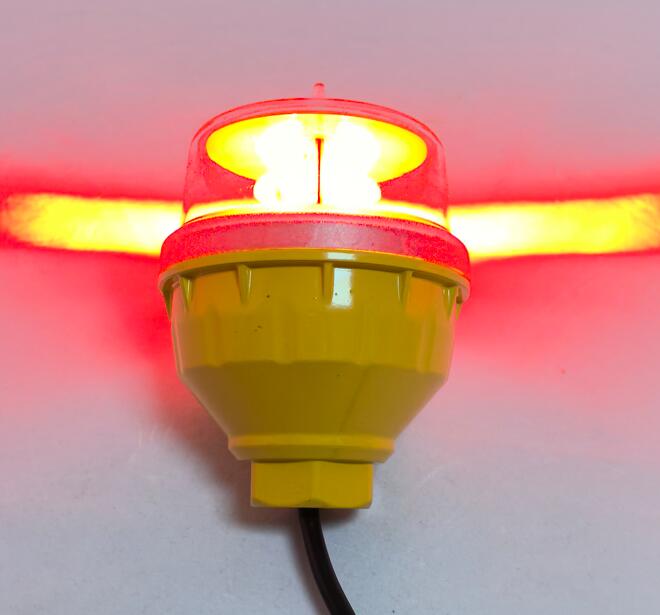L-810 Light: The Essential Guide to Low-Intensity Obstruction Lighting
In the world of aviation safety lighting, the L-810 light stands as a fundamental solution for marking low-to-medium height obstacles. As the most widely recognized low-intensity obstruction light, this red beacon plays a critical role in preventing collisions with structures that penetrate navigable airspace. This comprehensive guide explores the technical specifications, applications, and regulatory importance of L-810 light systems in modern aviation environments.
Understanding L-810 Light Standards
1. Regulatory Foundations
FAA AC 150/5345-43J compliance
ICAO Annex 14 certification
Meets FAR Part 77 requirements
TSO-C96 approval for aviation use

2. Key Technical Specifications
Light Output: 32.5 candela minimum
Color: Aviation red (620-660nm wavelength)
Flash Rate: 40-60 flashes per minute (when equipped)
Beam Spread: 10° vertical minimum
Power Requirements: 6.6W typical (LED versions)
Design and Construction Features
Modern L-810 light units incorporate advanced engineering:
1. Housing Materials
Aircraft-grade aluminum construction
UV-stabilized polycarbonate lenses
Corrosion-resistant hardware
IP66 weatherproof rating
2. Optical System
Precision-molded Fresnel lenses
LED light source technology
360° horizontal visibility
Optimized vertical dispersion
3. Mounting Options
Side-mount brackets
Top-mounted configurations
Pole-top installations
Custom mounting solutions
Primary Applications
L-810 light systems serve multiple critical functions:
1. Aviation Obstruction Marking
Communication towers under 150 feet
Building rooftops
Construction cranes
Wind turbines
2. Transportation Infrastructure
Bridge superstructures
Highway signage supports
Railroad crossings
3. Industrial Facilities
Power transmission towers
Refinery structures
Offshore platforms
Installation Best Practices
Proper deployment of L-810 light systems requires:
1. Site Assessment
Obstruction height evaluation
Airspace penetration analysis
Solar exposure for solar-powered units
2. Spacing Guidelines
50-100 foot vertical intervals
Multiple lights for large structures
Symmetrical placement patterns
3. Electrical Considerations
Circuit protection requirements
Voltage drop calculations
Backup power provisions
Maintenance Protocols
Ensuring continuous L-810 light performance involves:
1. Routine Inspections
Monthly visual checks
| l 810 light |
Quarterly photometric testing
Annual comprehensive review
2. Common Maintenance Tasks
Lens cleaning and polishing
Electrical connection verification
Housing integrity checks
3. Performance Documentation
Light output measurements
Battery health reports (solar systems)
Repair and replacement logs
LED Conversion Advantages
Modern L-810 light units benefit from LED technology:
Energy Efficiency
80% less power consumption
Reduced electrical load
Solar operation viability
Enhanced Reliability
50,000+ hour lifespan
Vibration resistance
Instant cold weather start
Maintenance Reduction
Fewer bulb replacements
Minimal lumen depreciation
Simplified servicing
Regulatory Compliance
L-810 light systems must meet stringent requirements:
1. Certification Standards
FAA TSO-C96
ICAO Annex 14
MIL-STD-810G (environmental)
IP66 (ingress protection)
2. Documentation Requirements
Installation records
Maintenance logs
Photometric test reports
Emerging Technologies
The future of L-810 light systems includes:
Smart Monitoring
Wireless status reporting
Predictive failure alerts
Remote configuration
Advanced Materials
Self-cleaning surfaces
Impact-resistant lenses
Nano-coated reflectors
Sustainable Solutions
Solar-hybrid systems
Energy harvesting
Recyclable components
The L-810 light remains an indispensable tool in aviation safety, providing reliable low-intensity obstruction marking for countless structures worldwide. As lighting technology advances, these systems continue to evolve - offering greater efficiency, smarter functionality, and enhanced reliability while maintaining compliance with strict aviation standards.
For facility managers, aviation authorities, and construction professionals, understanding L-810 light requirements and best practices is essential for ensuring airspace safety and regulatory compliance. The ongoing development of these lighting solutions promises to deliver even better performance as the aviation industry faces new challenges in an increasingly crowded airspace environment.
